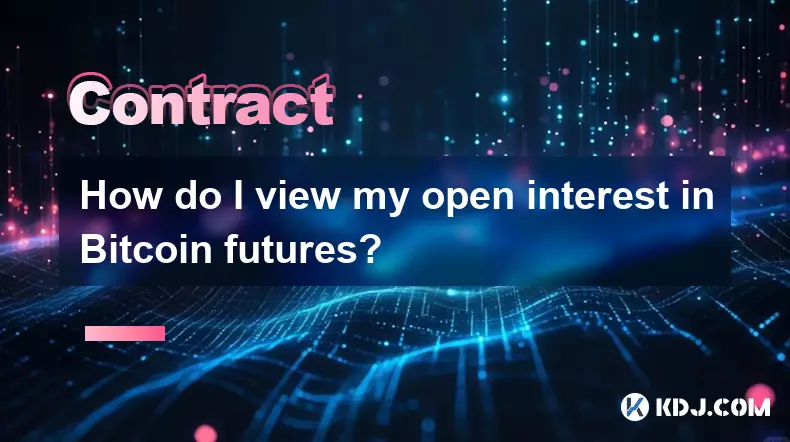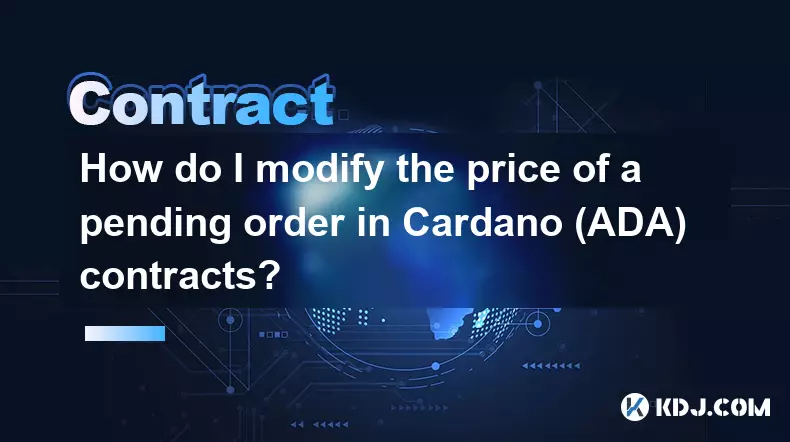-
 bitcoin
bitcoin $109667.069529 USD
-3.03% -
 ethereum
ethereum $3936.685804 USD
-4.07% -
 tether
tether $1.000493 USD
0.01% -
 xrp
xrp $2.771823 USD
-4.74% -
 bnb
bnb $957.805027 USD
-5.34% -
 solana
solana $196.735100 USD
-6.68% -
 usd-coin
usd-coin $0.999727 USD
-0.01% -
 dogecoin
dogecoin $0.227355 USD
-5.12% -
 tron
tron $0.335205 USD
-0.81% -
 cardano
cardano $0.779256 USD
-3.59% -
 ethena-usde
ethena-usde $0.999900 USD
-0.06% -
 hyperliquid
hyperliquid $42.492095 USD
-6.61% -
 chainlink
chainlink $20.501853 USD
-4.34% -
 avalanche
avalanche $28.952606 USD
-11.21% -
 stellar
stellar $0.356038 USD
-3.93%
How do I view my open interest in Bitcoin futures?
Open interest in Bitcoin futures reflects active, unsettled contracts and helps traders gauge market sentiment, liquidity, and potential trend strength.
Sep 26, 2025 at 11:36 am

Understanding Open Interest in Bitcoin Futures
1. Open interest refers to the total number of outstanding derivative contracts, such as futures, that have not been settled. In the context of Bitcoin futures, it reflects how many active positions remain open in the market at any given time. This metric is crucial for traders seeking insights into market sentiment and liquidity.
2. Unlike trading volume, which resets daily, open interest accumulates over time and changes only when new positions are opened or existing ones are closed. A rising open interest suggests new capital entering the market, often signaling sustained momentum. Conversely, declining open interest may indicate traders exiting their positions, potentially foreshadowing a trend reversal.
3. To monitor open interest effectively, traders must access platforms that provide real-time derivatives data. Major cryptocurrency exchanges and third-party analytics services offer this information through dashboards, charts, and APIs. Understanding where and how to locate this data is essential for informed decision-making.
4. Open interest is typically broken down by contract type—perpetual, quarterly, or biweekly futures—and by exchange. Each platform may present the data differently, so familiarity with the interface and terminology is important. Some platforms also offer historical open interest trends, enabling deeper analysis.
5. Institutional-grade tools often include filters for long versus short positions, helping users assess market bias. While retail traders may not have direct access to all these features, aggregated data from public sources can still provide meaningful insights into broader market behavior.
Platforms to Monitor Bitcoin Futures Open Interest
1. Bybit, Binance, and OKX are among the leading cryptocurrency exchanges offering built-in open interest tracking. These platforms display live data on their futures trading pages, often alongside price charts and order books. Users can toggle between different contract types to view specific open interest figures.
2. TradingView integrates open interest data from multiple exchanges, allowing users to overlay it on price charts. Custom scripts and community-shared indicators enhance the analytical capabilities, making it easier to correlate price movements with changes in open interest.
3. CoinGlass is a dedicated analytics platform that aggregates open interest across dozens of exchanges. It provides visualizations such as heatmaps, funding rate comparisons, and long-short ratios. The site breaks down data by asset, contract type, and exchange, offering a comprehensive overview.
4. CryptoQuant and Glassnode focus more on on-chain metrics but also include derivatives data. Their institutional dashboards track open interest in relation to other macro indicators like exchange reserves and miner flows, providing context beyond surface-level numbers.
5. Deribit, a major player in Bitcoin options and futures, publishes detailed reports and real-time stats on its website. Given its significant share of institutional activity, Deribit’s open interest is closely watched as a barometer of professional sentiment.
Interpreting Open Interest Trends
1. When price and open interest rise together, it often indicates new buying pressure. This alignment suggests confidence among long-position holders and potential continuation of an uptrend. Traders watch for sustained increases in both metrics as confirmation of bullish momentum.
2. If price rises while open interest falls, it may signal short covering rather than new buying. This scenario can reflect a lack of conviction in the rally, increasing the likelihood of a pullback once short sellers have exited.
3. A falling price accompanied by rising open interest points to aggressive short selling. New capital is entering on the bearish side, which could lead to further downside if the trend accelerates. However, excessive short positioning also raises the risk of a squeeze.
4. Declining price and falling open interest suggest position liquidation without strong new selling. This condition often occurs after a sharp move and may precede consolidation or a reversal as market participants step back.
5. Sudden spikes in open interest during low-volume periods can indicate large institutional orders. These anomalies warrant attention, especially if they coincide with macroeconomic events or regulatory announcements.
Frequently Asked Questions
What is the difference between open interest and trading volume?Open interest counts the total number of active futures contracts not yet settled, while trading volume measures the number of contracts traded within a specific period. Volume resets daily; open interest persists until positions are closed.
Can open interest be used to predict price direction?It cannot predict price directly but helps assess the strength behind price moves. Rising open interest during a trend suggests sustainability, whereas declining open interest may hint at weakening momentum.
Why does open interest vary across exchanges?Different exchanges host varying levels of institutional and retail participation. Regulatory frameworks, leverage offerings, and geographic user bases contribute to discrepancies in open interest distribution.
Does high open interest increase market risk?Elevated open interest can amplify volatility, particularly during liquidations. Markets with concentrated open interest are more susceptible to cascading sell-offs or short squeezes when prices reach key thresholds.
Disclaimer:info@kdj.com
The information provided is not trading advice. kdj.com does not assume any responsibility for any investments made based on the information provided in this article. Cryptocurrencies are highly volatile and it is highly recommended that you invest with caution after thorough research!
If you believe that the content used on this website infringes your copyright, please contact us immediately (info@kdj.com) and we will delete it promptly.
- Coin War, Durian Auction, Night Tour: A Wild Ride Through Crypto, Cuisine, and Korean TV
- 2025-09-27 08:45:14
- Cyber Hornet, ETFs, and Crypto: A New York Minute on Hybrid Investments
- 2025-09-27 08:25:12
- Bitcoin's Future Value: Prediction, Trends, and Insights
- 2025-09-27 08:45:14
- MoonBull: The Meme Market's 100x Crypto Contender?
- 2025-09-27 08:25:12
- Eric Trump, Crypto Market, and the Unbelievable Q4: A New York Take
- 2025-09-27 08:30:01
- Linea Crypto & SWIFT: What's the Price Prediction?
- 2025-09-27 08:50:01
Related knowledge

How do I enable the "scalping-only" mode for Cardano (ADA) contracts?
Sep 24,2025 at 03:19am
Understanding Scalping Strategies in Crypto Derivatives1. Scalping in cryptocurrency trading refers to executing multiple short-term trades within min...

What is the maximum position limit for Cardano (ADA) contracts?
Sep 23,2025 at 11:00pm
Understanding ADA Futures and Derivatives Market Structure1. Cardano (ADA) futures contracts are offered by several major cryptocurrency derivatives e...

What is the maker fee for Cardano (ADA) contracts?
Sep 26,2025 at 09:01am
Understanding Maker Fees in Cardano (ADA) Contracts1. The concept of maker fees applies broadly across decentralized exchanges and smart contract plat...

How can I view open interest in Cardano (ADA) contracts?
Sep 24,2025 at 07:36am
Understanding Open Interest in Cardano Derivatives1. Open interest refers to the total number of outstanding derivative contracts, such as futures or ...

How do I modify the price of a pending order in Cardano (ADA) contracts?
Sep 27,2025 at 01:00am
Understanding Pending Orders in Cardano Smart Contracts1. Cardano operates on a proof-of-stake blockchain that supports smart contracts through its Pl...

What is the function of the insurance fund in Cardano (ADA) contracts?
Sep 24,2025 at 02:18am
Understanding the Role of Insurance Funds in Cardano Smart Contracts1. The insurance fund within Cardano's ecosystem is not a native feature directly ...

How do I enable the "scalping-only" mode for Cardano (ADA) contracts?
Sep 24,2025 at 03:19am
Understanding Scalping Strategies in Crypto Derivatives1. Scalping in cryptocurrency trading refers to executing multiple short-term trades within min...

What is the maximum position limit for Cardano (ADA) contracts?
Sep 23,2025 at 11:00pm
Understanding ADA Futures and Derivatives Market Structure1. Cardano (ADA) futures contracts are offered by several major cryptocurrency derivatives e...

What is the maker fee for Cardano (ADA) contracts?
Sep 26,2025 at 09:01am
Understanding Maker Fees in Cardano (ADA) Contracts1. The concept of maker fees applies broadly across decentralized exchanges and smart contract plat...

How can I view open interest in Cardano (ADA) contracts?
Sep 24,2025 at 07:36am
Understanding Open Interest in Cardano Derivatives1. Open interest refers to the total number of outstanding derivative contracts, such as futures or ...

How do I modify the price of a pending order in Cardano (ADA) contracts?
Sep 27,2025 at 01:00am
Understanding Pending Orders in Cardano Smart Contracts1. Cardano operates on a proof-of-stake blockchain that supports smart contracts through its Pl...

What is the function of the insurance fund in Cardano (ADA) contracts?
Sep 24,2025 at 02:18am
Understanding the Role of Insurance Funds in Cardano Smart Contracts1. The insurance fund within Cardano's ecosystem is not a native feature directly ...
See all articles










































































